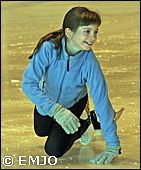Skating in Sweden – a visit to a summer camp
Text © Magdalena Osborne
Photos © EMJO
July may be a skating off-season month, but the off-season term is a matter of definition. At the “Kockum’s recreation center”, activities are going from early morning until sundown. |
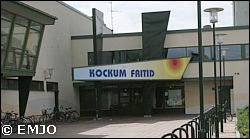
|
Located in the north part of Malmö, the facility offers just about anything a sports fan can dream of. There’s a pool, a bowling alley, a gym, table tennis and large rooms for gymnastics and dancing. And there’s a full size ice rink where, for the third consecutive year, the skating “Summer camp in Malmö” was in action when we visited. It was only 9 o’clock in the morning, and entering the rink was like stepping right back into winter; it was freezing! Yes, we expected it to be colder than the pleasant 20 something degrees Celsius we enjoyed outside, but this... The lobby felt like a sauna in comparison, and even with extra sweaters and fleece jackets we found ourselves going between the rink and the lobby all day to stay warm.
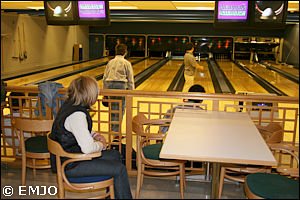 |
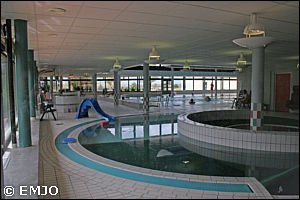 |
The students attending this camp were age 8 to 20, and many of them had been there before. They chose the coach and the type of classes they wanted, and were even offered choreography for their new programs. Most came from Sweden or Denmark, but previous years kids have also come from Norway and Iceland. The younger children had their families in a nearby hotel or hostel and made this a family vacation.
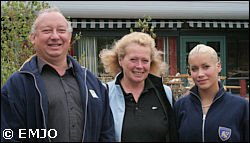 |
We met up with one of the camp organizers, Jannie Ringdahl of Inter Rider AB. Her husband Carl-Gustaf has contributed to some of my articles with his great skating photos. Their 16-year old daughter Josephine started skating when she was 4 and has attended a number of different camps, which served as inspiration to this one. |
“We have tried to pick out the best parts from all
the camps she’s been to”, Jannie told us. “We
want the kids who come here to be able to have as many sessions
a day as they want, plenty of room on the ice and get lots
of individual attention. They all get basic skating, but they
can also choose extra classes for spins and steps.”
The first session of the day was focused on spins. Coach Liana
Ocheretna was on the ice with 9 students, 8 of them girls.
She showed them different spin positions, and they all got
to try them and finally put them together. The cross sit spin
was particularity hard, and the kids were struggling. But
in spite of the cold and the level of difficulty, these kids
were eager to learn and they tried it over and over without
tiring.
“I know this spin is hard”, said Liana, who won
the Ukrainian champion title 3 times back when she was an
eligible skater. “Not many skaters use it, but I did
when I competed. If these kids learn it they will have an
edge.”
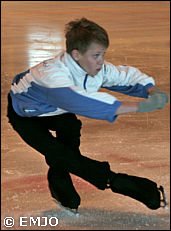 |
 |
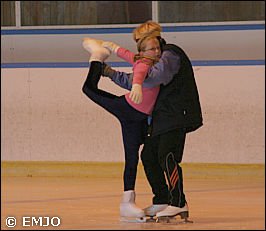 |
Liana has a degree in coaching from the Moscow Sports University
and has coached and choreographed for clubs both in Sweden
and in Denmark, but recently moved back to the Ukraine. She
has coached at this camp before.
“It’s quite hard because it’s very intense,
we’re on the ice all day long and get few breaks, but
it’s fun. I teach kids from beginners to those who are
participating in international competitions.”
In a corner on the far side of the ice, another coach worked
with 3 little Danish girls, all beginners. They skated in
a circle practicing crossovers. Even things like that, which
look so easy at Worlds, take a lot of practice and patience
from both coach and student. Grazyna Dudek has 20 some years
in coaching, and is a 5 time Polish champion. She competed
in the European and World championships, and even in the Olympics.
Denmark is her home now, and the girls with her on the ice
were from her club in Copenhagen. We caught up with her in
the dressing room between sessions.
|
“I coach here at the camp for the third time. I mostly teach kids from my own club, but also some Swedish students, basic skating, spins, jumps and making new programs. I also have a few beginners. We’re on the ice all day long and the kids come in different groups, which is good. |
They train in the morning or afternoon and then they have the rest of the day free. This facility is very nice but also very cold, the rink is freezing! We have to come in here to warm up between sessions!”
That wasn’t hard to believe, we did too! But most of
the kids didn’t seem bothered by the cold, and some
were on the ice for 3 straight sessions! A few stuck out as
extra dedicated. Such was Nicole Svensson, who lives and trains
in Malmö. While watching Nicole we talked to her mother
Monika:
“Nicole is 10, and has only skated for 1½ years, so she started quite late. She used to be into horseback riding but gave that up so she could skate. My husband and I like to go skating as a family, but purely for fun! We wear hockey skates, and they are nothing like Nicole’s Grafs. One time when she was about 5, there were some girls on the ice, and they wore skirts and no helmets. Nicole stopped and watched them and then said ‘Mom, I want to be an ice princess!’ |
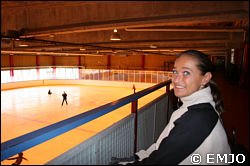 |
Eventually we put her in something called a ‘hobby group’ where she skated only once a week. But after a few months she started in figure skating and now there’s training 6 times a week. She just loves it; she wants to skate all the rime! I don’t know much about skating, but to me she looks pretty on the ice.”
 |
 |
We had to agree. For someone who’d only skated seriously
for a year, Nicole was good!
But getting her this far took some doing for the family.
“I’m off work now so I can be here watching”,
Monika said, “but I work full time and my husband has
his own business. There’s a lot of driving her back
and forth to practice, and our work schedules don’t
allow that. Luckily my dad is retired and he does a lot of
the driving. I know 6 times a week is a lot for a child her
age, but she wants to, she has incredible willpower! Nicole
loves her coaches too, both for skating and ballet. As part
of the training she has 2 ballet classes a week. She just
can’t get enough of the sport! She spent the last 3
weeks at another camp and is now here... The back side is
all the bruises on her legs. I had to talk to her teachers
at school or they would have thought we abuse her. When the
training was out in the spring, she didn’t skate for
a few weeks and her legs looked so normal and pretty. But
now all the bruises are back again. *Sigh*
This is a good camp! Nicole has plenty of ice time and gets
lots of individual help. She’s happy so I’m happy!”
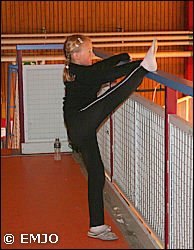 |
Our toes were numb and it was time to go for a walk to try to stay warm. We walked past Freja Valdsgaard from Denmark as she was warming up. She put her leg up on the railing with such ease it made us jealous. It’s a good thing EMJO speaks Danish since I don’t... Freja told us she’s 9 and started skating at age 3. She had attended both camp weeks and liked the jump sessions the best. Her favorite jump is the Axel. |
Josephine Ringdahl was now on
the ice helping some students. She had a very successful last
season, placing 3rd at the Swedish Nationals and 4th at the
Nordics. But recently she decided to quit competitive skating.
“She wants to concentrate on her studies”, Jannie
explained. “She has been on the Swedish National Team
for several years and participated in several international
competitions. She has also trained in France with Annick Dumont
and Pierre Trente. She’s very artistic and the last
few years she choreographed her own programs.”
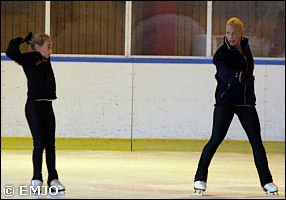 |
 |
Jannie and family were pretty worn out after the very demanding
camp weeks and started to look forward to some vacation time.
But that was still a few days away.
“We’ll close on Friday with a competition, like
spins or a combination of jumps and spins, or maybe Powerskating.
It will be fun and something the kids will remember.”
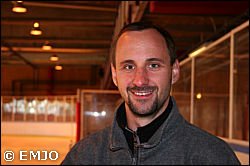 |
We observed several more sessions. Robert
Grzegorczyk, head coach in Trelleborg (southern
Sweden), taught steps. Like the other coaches, Robert
was once an eligible skater, winning the Polish nationals
a total of 8 times. |
“The coaches work very hard here, and the students
do too. But when I was eligible I trained 6 hours a day, so
this is normal. I help many of the students this week with
technique, spins and jumps. Even if Sweden hasn’t applied
the Code of Points yet (maybe next year, it’s a matter
of money), the kids need to be prepared.”
His wonderful sense of humor won the group over in no time,
and they followed him on the ice and looked like they had
a great time.
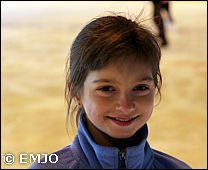  |
One little girl smiled all the time,
even when she fell. Not that she fell that often, and
we were both impressed by her speed and flexibility.
When we wanted to ask some questions she seemed a little
shy but agreed. Not bad for a first interview! When her skating sessions were over we even got a few words with her mother, Svetlana. She used to be an ice dancer and even competed some, but emphasized that her team was not well known at all. They started training for Natalia Linichuk in Moscow, but Svetlana’s partner had to go in the army and they never got back together after that. |
|
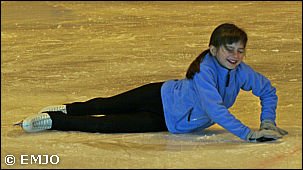 |
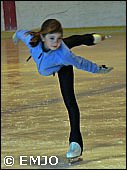 |
“It’s really too bad there’s no ice dancing here. I love skating and I miss it so much! I work with system’s development now... Our son plays hockey and I never pushed Pålina to skate. She did it for fun but then she qualified to go to competitions and really fell in love with the sport. I will not stop her now. She was at this camp 2 years ago and it’s very close for us so it’s convenient. And she loves working with Robert!"
 |
Everyone seemed content, even one of
only two boys, heavily outnumbered by the female students.
Alywin Ianchenko, also
from Malmö, is 11 and tried hard not to 2 foot
the landing of his double loop. |
We left the rink in awe over the dedication and joy of
skating we’d witnessed, and who knows, maybe in a few
years some of these kids will have their names on the roster
for Europeans!
 |
 |
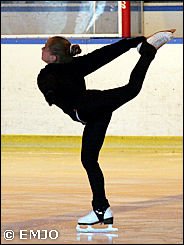 |





